International Relations Theory: Analyzing State Behavior and Factors
VerifiedAdded on 2022/12/21
|11
|2776
|65
Essay
AI Summary
This essay delves into the multifaceted concept of state behavior within the framework of international relations. It meticulously examines the factors that shape a state's actions, including the influence of family values, sex, religion, ethnicity, and race, and how these elements contribute to the creation of norms and values. The analysis is grounded in realism theories, particularly classical, structural, and neoclassical realism, to evaluate how these perspectives illuminate state behavior. The essay discusses how these factors impact the behavior of states and their approaches to international politics, providing a comprehensive understanding of the complex interplay between internal societal elements and external international relations. The essay also discusses how the factors like sex, religion, race, and ethnicity determine the behavior of political states. The essay concludes by emphasizing the significance of societal norms in directing state behavior and the application of various realism theories in comprehending the actions of nations on the global stage.
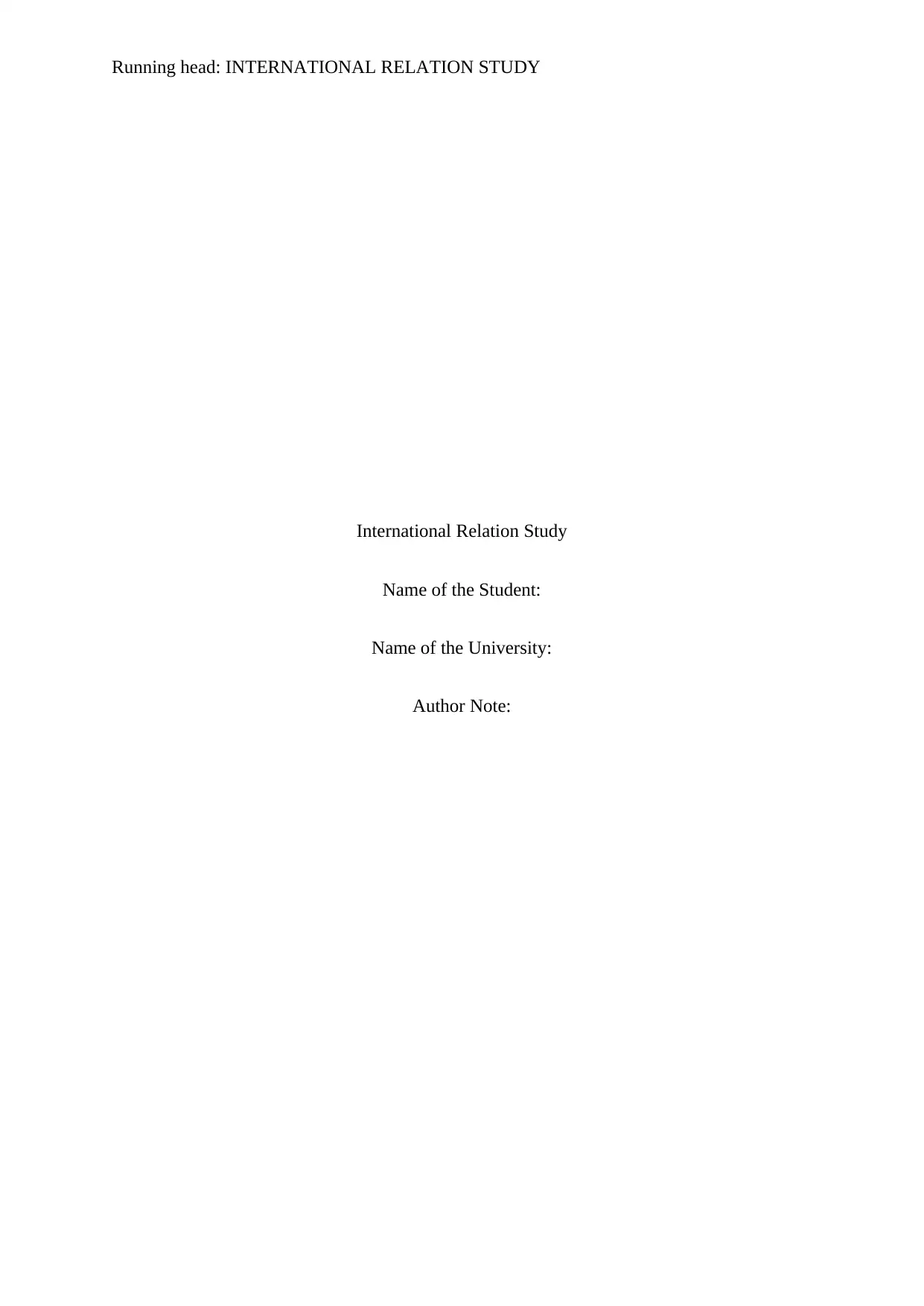
Running head: INTERNATIONAL RELATION STUDY
International Relation Study
Name of the Student:
Name of the University:
Author Note:
International Relation Study
Name of the Student:
Name of the University:
Author Note:
Paraphrase This Document
Need a fresh take? Get an instant paraphrase of this document with our AI Paraphraser
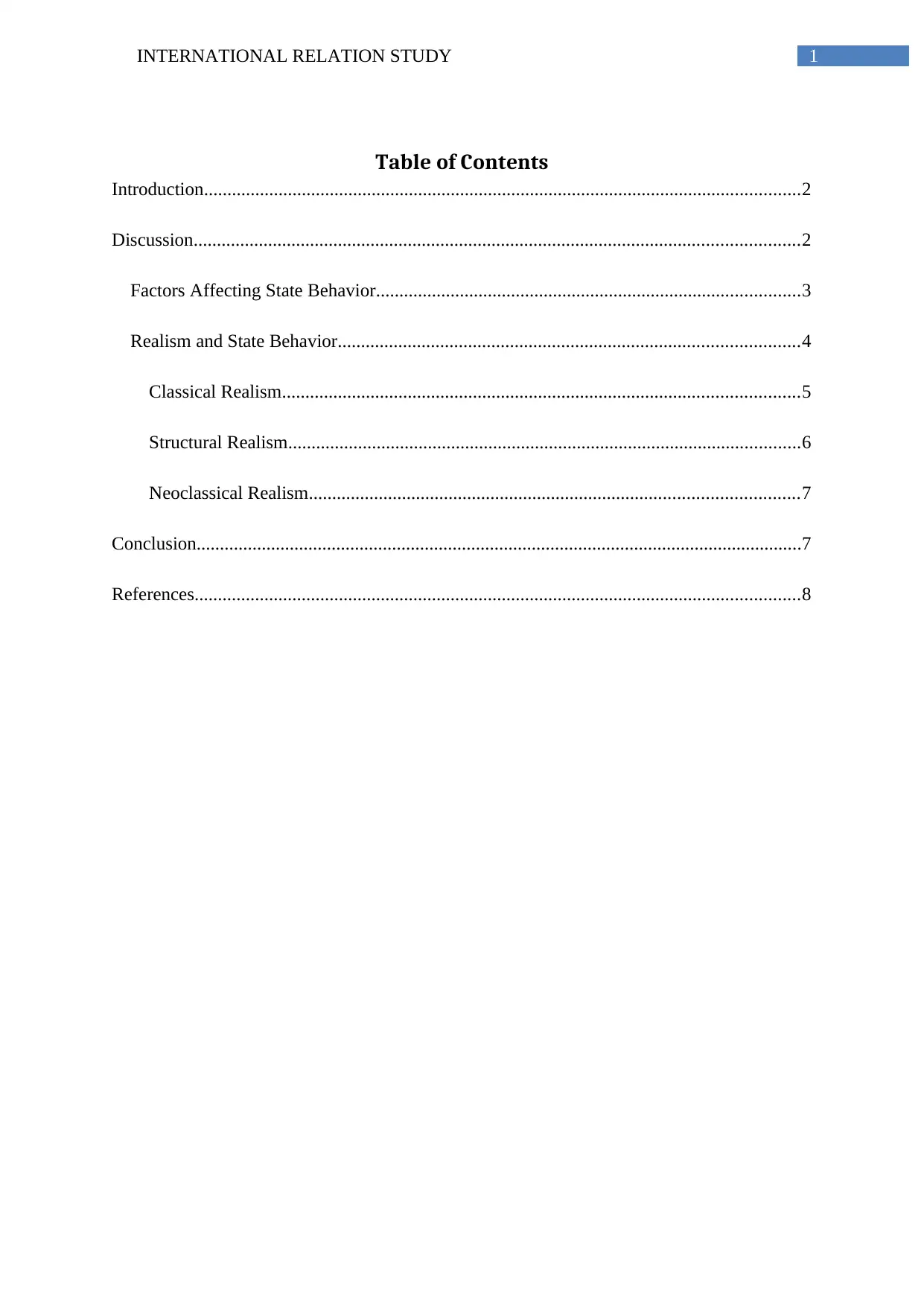
1INTERNATIONAL RELATION STUDY
Table of Contents
Introduction................................................................................................................................2
Discussion..................................................................................................................................2
Factors Affecting State Behavior...........................................................................................3
Realism and State Behavior...................................................................................................4
Classical Realism...............................................................................................................5
Structural Realism..............................................................................................................6
Neoclassical Realism.........................................................................................................7
Conclusion..................................................................................................................................7
References..................................................................................................................................8
Table of Contents
Introduction................................................................................................................................2
Discussion..................................................................................................................................2
Factors Affecting State Behavior...........................................................................................3
Realism and State Behavior...................................................................................................4
Classical Realism...............................................................................................................5
Structural Realism..............................................................................................................6
Neoclassical Realism.........................................................................................................7
Conclusion..................................................................................................................................7
References..................................................................................................................................8
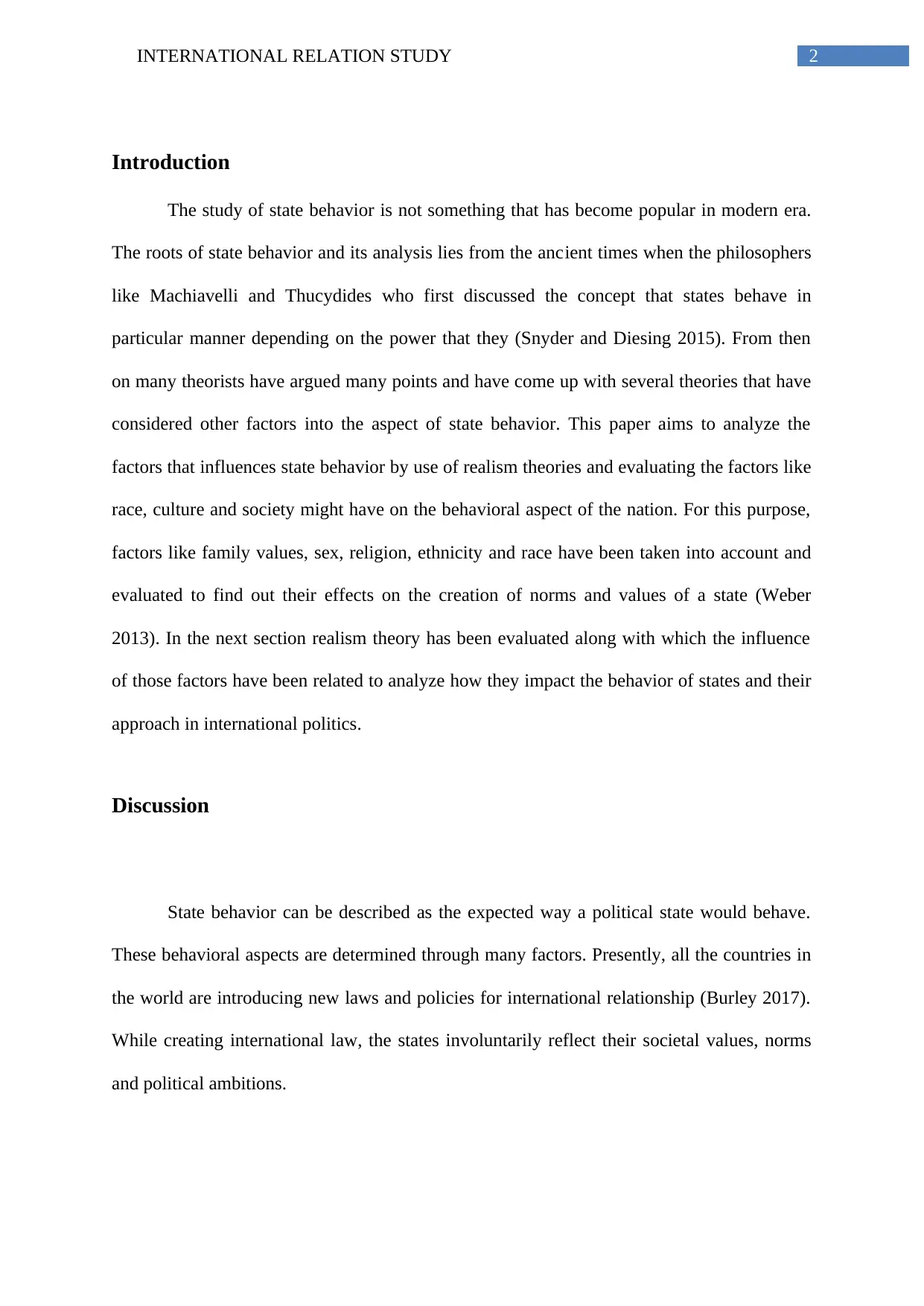
2INTERNATIONAL RELATION STUDY
Introduction
The study of state behavior is not something that has become popular in modern era.
The roots of state behavior and its analysis lies from the ancient times when the philosophers
like Machiavelli and Thucydides who first discussed the concept that states behave in
particular manner depending on the power that they (Snyder and Diesing 2015). From then
on many theorists have argued many points and have come up with several theories that have
considered other factors into the aspect of state behavior. This paper aims to analyze the
factors that influences state behavior by use of realism theories and evaluating the factors like
race, culture and society might have on the behavioral aspect of the nation. For this purpose,
factors like family values, sex, religion, ethnicity and race have been taken into account and
evaluated to find out their effects on the creation of norms and values of a state (Weber
2013). In the next section realism theory has been evaluated along with which the influence
of those factors have been related to analyze how they impact the behavior of states and their
approach in international politics.
Discussion
State behavior can be described as the expected way a political state would behave.
These behavioral aspects are determined through many factors. Presently, all the countries in
the world are introducing new laws and policies for international relationship (Burley 2017).
While creating international law, the states involuntarily reflect their societal values, norms
and political ambitions.
Introduction
The study of state behavior is not something that has become popular in modern era.
The roots of state behavior and its analysis lies from the ancient times when the philosophers
like Machiavelli and Thucydides who first discussed the concept that states behave in
particular manner depending on the power that they (Snyder and Diesing 2015). From then
on many theorists have argued many points and have come up with several theories that have
considered other factors into the aspect of state behavior. This paper aims to analyze the
factors that influences state behavior by use of realism theories and evaluating the factors like
race, culture and society might have on the behavioral aspect of the nation. For this purpose,
factors like family values, sex, religion, ethnicity and race have been taken into account and
evaluated to find out their effects on the creation of norms and values of a state (Weber
2013). In the next section realism theory has been evaluated along with which the influence
of those factors have been related to analyze how they impact the behavior of states and their
approach in international politics.
Discussion
State behavior can be described as the expected way a political state would behave.
These behavioral aspects are determined through many factors. Presently, all the countries in
the world are introducing new laws and policies for international relationship (Burley 2017).
While creating international law, the states involuntarily reflect their societal values, norms
and political ambitions.
⊘ This is a preview!⊘
Do you want full access?
Subscribe today to unlock all pages.

Trusted by 1+ million students worldwide
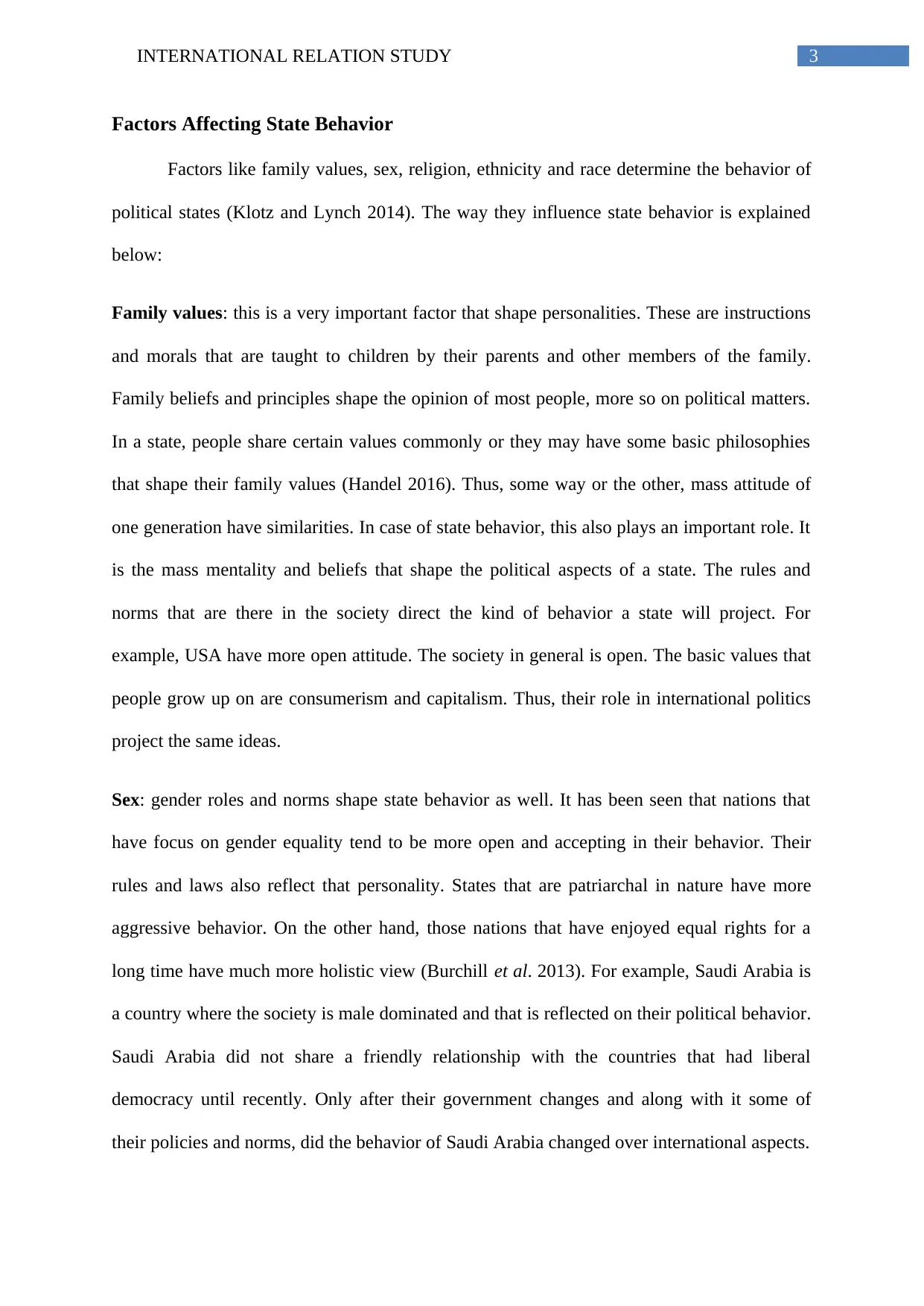
3INTERNATIONAL RELATION STUDY
Factors Affecting State Behavior
Factors like family values, sex, religion, ethnicity and race determine the behavior of
political states (Klotz and Lynch 2014). The way they influence state behavior is explained
below:
Family values: this is a very important factor that shape personalities. These are instructions
and morals that are taught to children by their parents and other members of the family.
Family beliefs and principles shape the opinion of most people, more so on political matters.
In a state, people share certain values commonly or they may have some basic philosophies
that shape their family values (Handel 2016). Thus, some way or the other, mass attitude of
one generation have similarities. In case of state behavior, this also plays an important role. It
is the mass mentality and beliefs that shape the political aspects of a state. The rules and
norms that are there in the society direct the kind of behavior a state will project. For
example, USA have more open attitude. The society in general is open. The basic values that
people grow up on are consumerism and capitalism. Thus, their role in international politics
project the same ideas.
Sex: gender roles and norms shape state behavior as well. It has been seen that nations that
have focus on gender equality tend to be more open and accepting in their behavior. Their
rules and laws also reflect that personality. States that are patriarchal in nature have more
aggressive behavior. On the other hand, those nations that have enjoyed equal rights for a
long time have much more holistic view (Burchill et al. 2013). For example, Saudi Arabia is
a country where the society is male dominated and that is reflected on their political behavior.
Saudi Arabia did not share a friendly relationship with the countries that had liberal
democracy until recently. Only after their government changes and along with it some of
their policies and norms, did the behavior of Saudi Arabia changed over international aspects.
Factors Affecting State Behavior
Factors like family values, sex, religion, ethnicity and race determine the behavior of
political states (Klotz and Lynch 2014). The way they influence state behavior is explained
below:
Family values: this is a very important factor that shape personalities. These are instructions
and morals that are taught to children by their parents and other members of the family.
Family beliefs and principles shape the opinion of most people, more so on political matters.
In a state, people share certain values commonly or they may have some basic philosophies
that shape their family values (Handel 2016). Thus, some way or the other, mass attitude of
one generation have similarities. In case of state behavior, this also plays an important role. It
is the mass mentality and beliefs that shape the political aspects of a state. The rules and
norms that are there in the society direct the kind of behavior a state will project. For
example, USA have more open attitude. The society in general is open. The basic values that
people grow up on are consumerism and capitalism. Thus, their role in international politics
project the same ideas.
Sex: gender roles and norms shape state behavior as well. It has been seen that nations that
have focus on gender equality tend to be more open and accepting in their behavior. Their
rules and laws also reflect that personality. States that are patriarchal in nature have more
aggressive behavior. On the other hand, those nations that have enjoyed equal rights for a
long time have much more holistic view (Burchill et al. 2013). For example, Saudi Arabia is
a country where the society is male dominated and that is reflected on their political behavior.
Saudi Arabia did not share a friendly relationship with the countries that had liberal
democracy until recently. Only after their government changes and along with it some of
their policies and norms, did the behavior of Saudi Arabia changed over international aspects.
Paraphrase This Document
Need a fresh take? Get an instant paraphrase of this document with our AI Paraphraser
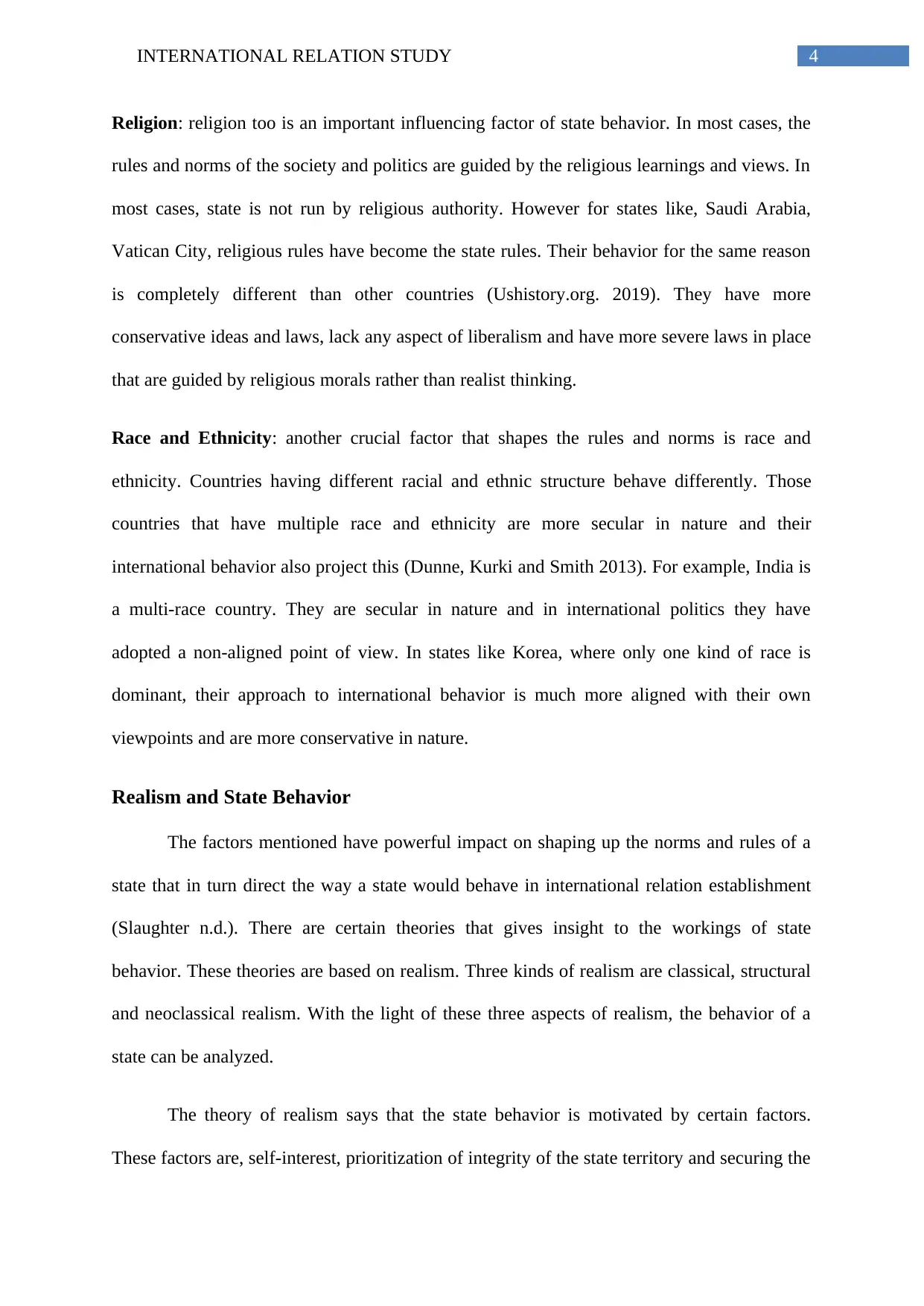
4INTERNATIONAL RELATION STUDY
Religion: religion too is an important influencing factor of state behavior. In most cases, the
rules and norms of the society and politics are guided by the religious learnings and views. In
most cases, state is not run by religious authority. However for states like, Saudi Arabia,
Vatican City, religious rules have become the state rules. Their behavior for the same reason
is completely different than other countries (Ushistory.org. 2019). They have more
conservative ideas and laws, lack any aspect of liberalism and have more severe laws in place
that are guided by religious morals rather than realist thinking.
Race and Ethnicity: another crucial factor that shapes the rules and norms is race and
ethnicity. Countries having different racial and ethnic structure behave differently. Those
countries that have multiple race and ethnicity are more secular in nature and their
international behavior also project this (Dunne, Kurki and Smith 2013). For example, India is
a multi-race country. They are secular in nature and in international politics they have
adopted a non-aligned point of view. In states like Korea, where only one kind of race is
dominant, their approach to international behavior is much more aligned with their own
viewpoints and are more conservative in nature.
Realism and State Behavior
The factors mentioned have powerful impact on shaping up the norms and rules of a
state that in turn direct the way a state would behave in international relation establishment
(Slaughter n.d.). There are certain theories that gives insight to the workings of state
behavior. These theories are based on realism. Three kinds of realism are classical, structural
and neoclassical realism. With the light of these three aspects of realism, the behavior of a
state can be analyzed.
The theory of realism says that the state behavior is motivated by certain factors.
These factors are, self-interest, prioritization of integrity of the state territory and securing the
Religion: religion too is an important influencing factor of state behavior. In most cases, the
rules and norms of the society and politics are guided by the religious learnings and views. In
most cases, state is not run by religious authority. However for states like, Saudi Arabia,
Vatican City, religious rules have become the state rules. Their behavior for the same reason
is completely different than other countries (Ushistory.org. 2019). They have more
conservative ideas and laws, lack any aspect of liberalism and have more severe laws in place
that are guided by religious morals rather than realist thinking.
Race and Ethnicity: another crucial factor that shapes the rules and norms is race and
ethnicity. Countries having different racial and ethnic structure behave differently. Those
countries that have multiple race and ethnicity are more secular in nature and their
international behavior also project this (Dunne, Kurki and Smith 2013). For example, India is
a multi-race country. They are secular in nature and in international politics they have
adopted a non-aligned point of view. In states like Korea, where only one kind of race is
dominant, their approach to international behavior is much more aligned with their own
viewpoints and are more conservative in nature.
Realism and State Behavior
The factors mentioned have powerful impact on shaping up the norms and rules of a
state that in turn direct the way a state would behave in international relation establishment
(Slaughter n.d.). There are certain theories that gives insight to the workings of state
behavior. These theories are based on realism. Three kinds of realism are classical, structural
and neoclassical realism. With the light of these three aspects of realism, the behavior of a
state can be analyzed.
The theory of realism says that the state behavior is motivated by certain factors.
These factors are, self-interest, prioritization of integrity of the state territory and securing the
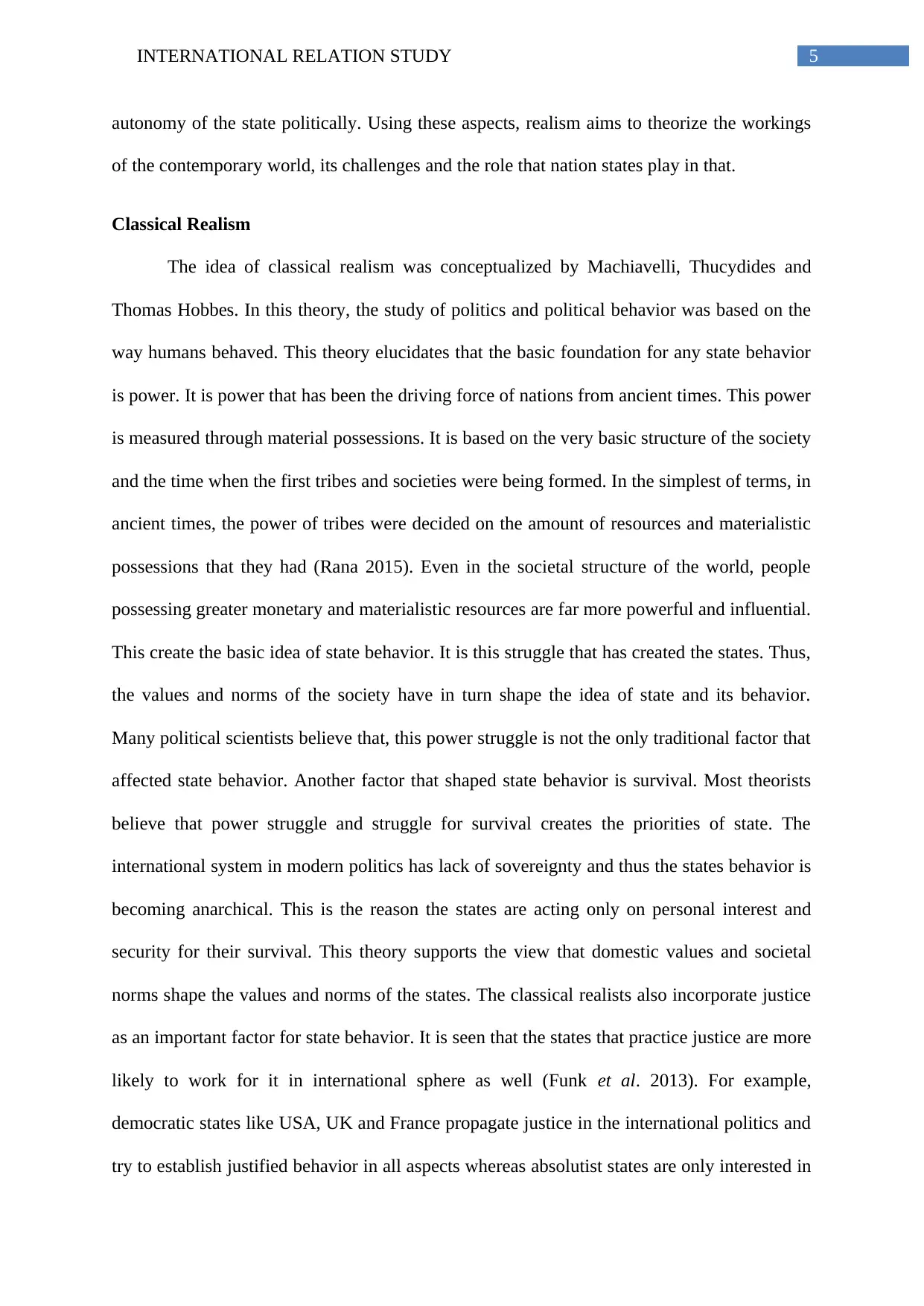
5INTERNATIONAL RELATION STUDY
autonomy of the state politically. Using these aspects, realism aims to theorize the workings
of the contemporary world, its challenges and the role that nation states play in that.
Classical Realism
The idea of classical realism was conceptualized by Machiavelli, Thucydides and
Thomas Hobbes. In this theory, the study of politics and political behavior was based on the
way humans behaved. This theory elucidates that the basic foundation for any state behavior
is power. It is power that has been the driving force of nations from ancient times. This power
is measured through material possessions. It is based on the very basic structure of the society
and the time when the first tribes and societies were being formed. In the simplest of terms, in
ancient times, the power of tribes were decided on the amount of resources and materialistic
possessions that they had (Rana 2015). Even in the societal structure of the world, people
possessing greater monetary and materialistic resources are far more powerful and influential.
This create the basic idea of state behavior. It is this struggle that has created the states. Thus,
the values and norms of the society have in turn shape the idea of state and its behavior.
Many political scientists believe that, this power struggle is not the only traditional factor that
affected state behavior. Another factor that shaped state behavior is survival. Most theorists
believe that power struggle and struggle for survival creates the priorities of state. The
international system in modern politics has lack of sovereignty and thus the states behavior is
becoming anarchical. This is the reason the states are acting only on personal interest and
security for their survival. This theory supports the view that domestic values and societal
norms shape the values and norms of the states. The classical realists also incorporate justice
as an important factor for state behavior. It is seen that the states that practice justice are more
likely to work for it in international sphere as well (Funk et al. 2013). For example,
democratic states like USA, UK and France propagate justice in the international politics and
try to establish justified behavior in all aspects whereas absolutist states are only interested in
autonomy of the state politically. Using these aspects, realism aims to theorize the workings
of the contemporary world, its challenges and the role that nation states play in that.
Classical Realism
The idea of classical realism was conceptualized by Machiavelli, Thucydides and
Thomas Hobbes. In this theory, the study of politics and political behavior was based on the
way humans behaved. This theory elucidates that the basic foundation for any state behavior
is power. It is power that has been the driving force of nations from ancient times. This power
is measured through material possessions. It is based on the very basic structure of the society
and the time when the first tribes and societies were being formed. In the simplest of terms, in
ancient times, the power of tribes were decided on the amount of resources and materialistic
possessions that they had (Rana 2015). Even in the societal structure of the world, people
possessing greater monetary and materialistic resources are far more powerful and influential.
This create the basic idea of state behavior. It is this struggle that has created the states. Thus,
the values and norms of the society have in turn shape the idea of state and its behavior.
Many political scientists believe that, this power struggle is not the only traditional factor that
affected state behavior. Another factor that shaped state behavior is survival. Most theorists
believe that power struggle and struggle for survival creates the priorities of state. The
international system in modern politics has lack of sovereignty and thus the states behavior is
becoming anarchical. This is the reason the states are acting only on personal interest and
security for their survival. This theory supports the view that domestic values and societal
norms shape the values and norms of the states. The classical realists also incorporate justice
as an important factor for state behavior. It is seen that the states that practice justice are more
likely to work for it in international sphere as well (Funk et al. 2013). For example,
democratic states like USA, UK and France propagate justice in the international politics and
try to establish justified behavior in all aspects whereas absolutist states are only interested in
⊘ This is a preview!⊘
Do you want full access?
Subscribe today to unlock all pages.

Trusted by 1+ million students worldwide

6INTERNATIONAL RELATION STUDY
their personal gain. This also has some negative impacts like irrational and hazardous
decision that leaders of nations might take from their driven sense of justice thus creating a
catastrophic condition in the world politics. Prime example for this is Hitler’s rule in
Germany, where driven by the acute sense of injustice committed on Germans, Hitler
established a government that in turn became the reason behind Holocaust, the largest human
massacre in world history. This theory fails to explain the aspects of international relation and
cooperation. This theory only proposes the very basics of state behavior and is too rigid and
conservative in most arguments.
Structural Realism
The founder of the idea of structural realism was Kenneth Waltz and he theorizes that
state behavior is dependent upon their considerations on risks and analysis of cost for any
irrational factors. This is how a state maintains the stability of its structure. While it is true
that every state is not at war with any other state, the chances that it might occur at point of
time and the subsequent losses in human and state resources that drives the behavior of the
state. For example, the post-World War I scenario showed disarmament treaties where the
more powerful nations forced the weaker nations to stop arm empowerment to reduce threat
to their state (Fox 2018). According to the structural realists, the nations should always be
prepared for war and their guards should always be up for any disaster. It is necessary that
nations have enough resources at their disposal to be capable of defending against any
aggression. It can be further explained if the recent political trend is analyzed. The countries
that were directly involved in the World Wars are wearier of wars and thus have heavy
military forces at their disposal as well as nuclear powers as opposed to the developing
nations that only experienced the effects of the World Wars passively. The problem with this
theory is that this presents the world view in an extreme negative manner where all other
their personal gain. This also has some negative impacts like irrational and hazardous
decision that leaders of nations might take from their driven sense of justice thus creating a
catastrophic condition in the world politics. Prime example for this is Hitler’s rule in
Germany, where driven by the acute sense of injustice committed on Germans, Hitler
established a government that in turn became the reason behind Holocaust, the largest human
massacre in world history. This theory fails to explain the aspects of international relation and
cooperation. This theory only proposes the very basics of state behavior and is too rigid and
conservative in most arguments.
Structural Realism
The founder of the idea of structural realism was Kenneth Waltz and he theorizes that
state behavior is dependent upon their considerations on risks and analysis of cost for any
irrational factors. This is how a state maintains the stability of its structure. While it is true
that every state is not at war with any other state, the chances that it might occur at point of
time and the subsequent losses in human and state resources that drives the behavior of the
state. For example, the post-World War I scenario showed disarmament treaties where the
more powerful nations forced the weaker nations to stop arm empowerment to reduce threat
to their state (Fox 2018). According to the structural realists, the nations should always be
prepared for war and their guards should always be up for any disaster. It is necessary that
nations have enough resources at their disposal to be capable of defending against any
aggression. It can be further explained if the recent political trend is analyzed. The countries
that were directly involved in the World Wars are wearier of wars and thus have heavy
military forces at their disposal as well as nuclear powers as opposed to the developing
nations that only experienced the effects of the World Wars passively. The problem with this
theory is that this presents the world view in an extreme negative manner where all other
Paraphrase This Document
Need a fresh take? Get an instant paraphrase of this document with our AI Paraphraser
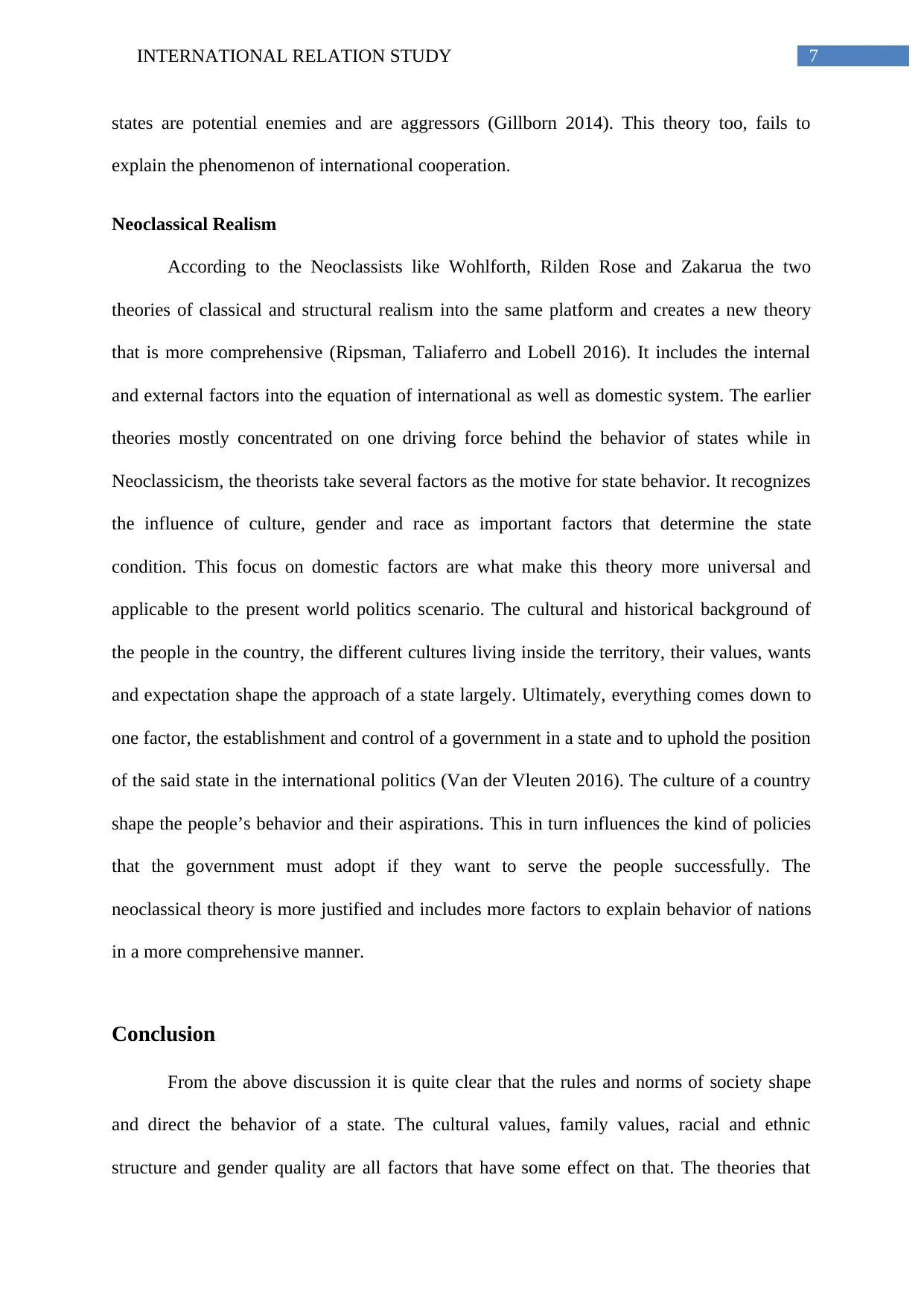
7INTERNATIONAL RELATION STUDY
states are potential enemies and are aggressors (Gillborn 2014). This theory too, fails to
explain the phenomenon of international cooperation.
Neoclassical Realism
According to the Neoclassists like Wohlforth, Rilden Rose and Zakarua the two
theories of classical and structural realism into the same platform and creates a new theory
that is more comprehensive (Ripsman, Taliaferro and Lobell 2016). It includes the internal
and external factors into the equation of international as well as domestic system. The earlier
theories mostly concentrated on one driving force behind the behavior of states while in
Neoclassicism, the theorists take several factors as the motive for state behavior. It recognizes
the influence of culture, gender and race as important factors that determine the state
condition. This focus on domestic factors are what make this theory more universal and
applicable to the present world politics scenario. The cultural and historical background of
the people in the country, the different cultures living inside the territory, their values, wants
and expectation shape the approach of a state largely. Ultimately, everything comes down to
one factor, the establishment and control of a government in a state and to uphold the position
of the said state in the international politics (Van der Vleuten 2016). The culture of a country
shape the people’s behavior and their aspirations. This in turn influences the kind of policies
that the government must adopt if they want to serve the people successfully. The
neoclassical theory is more justified and includes more factors to explain behavior of nations
in a more comprehensive manner.
Conclusion
From the above discussion it is quite clear that the rules and norms of society shape
and direct the behavior of a state. The cultural values, family values, racial and ethnic
structure and gender quality are all factors that have some effect on that. The theories that
states are potential enemies and are aggressors (Gillborn 2014). This theory too, fails to
explain the phenomenon of international cooperation.
Neoclassical Realism
According to the Neoclassists like Wohlforth, Rilden Rose and Zakarua the two
theories of classical and structural realism into the same platform and creates a new theory
that is more comprehensive (Ripsman, Taliaferro and Lobell 2016). It includes the internal
and external factors into the equation of international as well as domestic system. The earlier
theories mostly concentrated on one driving force behind the behavior of states while in
Neoclassicism, the theorists take several factors as the motive for state behavior. It recognizes
the influence of culture, gender and race as important factors that determine the state
condition. This focus on domestic factors are what make this theory more universal and
applicable to the present world politics scenario. The cultural and historical background of
the people in the country, the different cultures living inside the territory, their values, wants
and expectation shape the approach of a state largely. Ultimately, everything comes down to
one factor, the establishment and control of a government in a state and to uphold the position
of the said state in the international politics (Van der Vleuten 2016). The culture of a country
shape the people’s behavior and their aspirations. This in turn influences the kind of policies
that the government must adopt if they want to serve the people successfully. The
neoclassical theory is more justified and includes more factors to explain behavior of nations
in a more comprehensive manner.
Conclusion
From the above discussion it is quite clear that the rules and norms of society shape
and direct the behavior of a state. The cultural values, family values, racial and ethnic
structure and gender quality are all factors that have some effect on that. The theories that

8INTERNATIONAL RELATION STUDY
have concentrated on state behavior have described the factors that drive nations to behave in
a certain manner. The earlier theories only factorizes any one aspect that influences state
behavior while the recent theory of Neoclassicism incorporates many factors, internal and
external into the theory. From this discussion, it can be easily concluded that state behavior is
the result of cultural, societal as well as historical context of any state and the change that
state behavior goes through is also related to the changing structure of the society and
adoption of new culture due to globalization.
have concentrated on state behavior have described the factors that drive nations to behave in
a certain manner. The earlier theories only factorizes any one aspect that influences state
behavior while the recent theory of Neoclassicism incorporates many factors, internal and
external into the theory. From this discussion, it can be easily concluded that state behavior is
the result of cultural, societal as well as historical context of any state and the change that
state behavior goes through is also related to the changing structure of the society and
adoption of new culture due to globalization.
⊘ This is a preview!⊘
Do you want full access?
Subscribe today to unlock all pages.

Trusted by 1+ million students worldwide
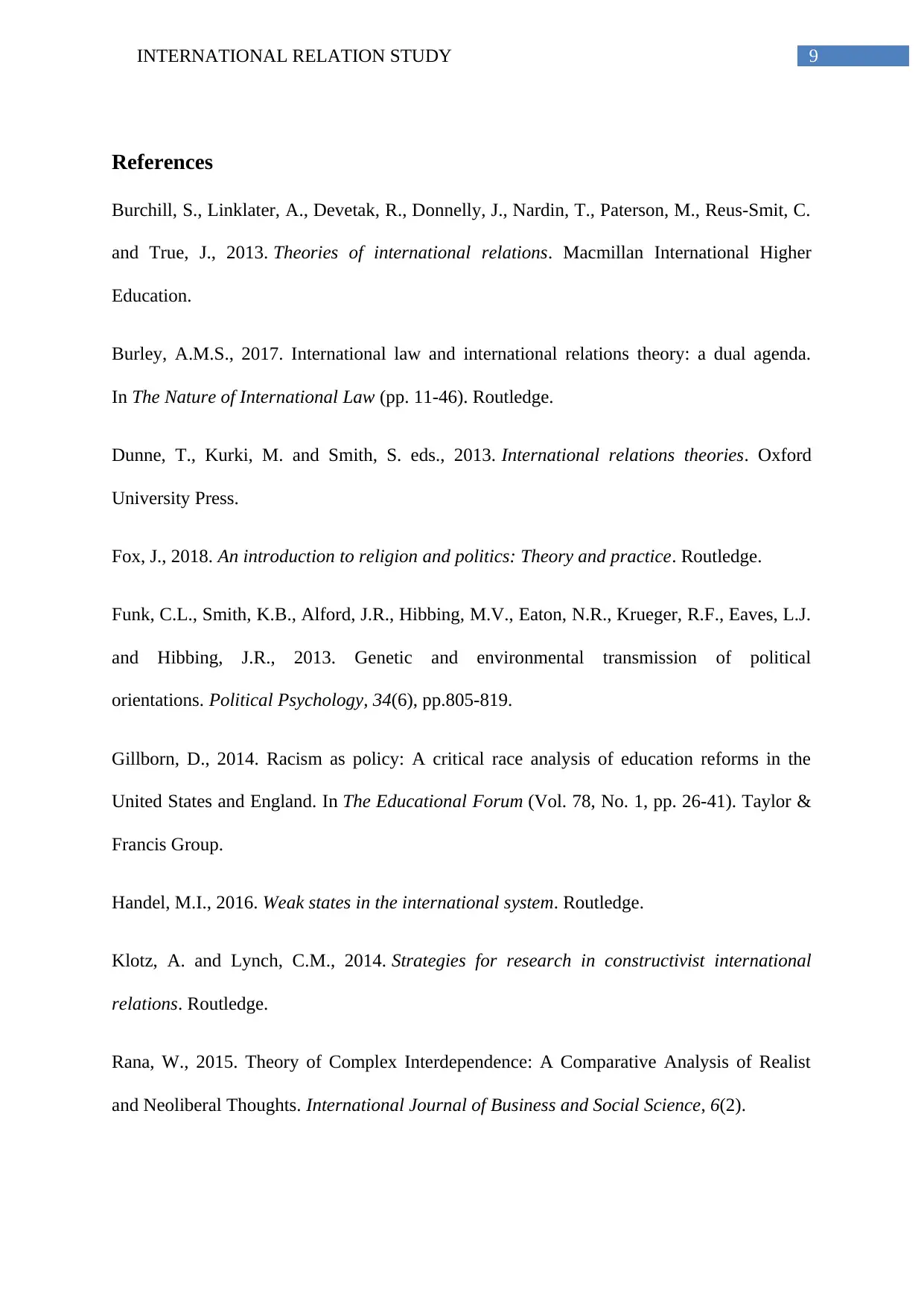
9INTERNATIONAL RELATION STUDY
References
Burchill, S., Linklater, A., Devetak, R., Donnelly, J., Nardin, T., Paterson, M., Reus-Smit, C.
and True, J., 2013. Theories of international relations. Macmillan International Higher
Education.
Burley, A.M.S., 2017. International law and international relations theory: a dual agenda.
In The Nature of International Law (pp. 11-46). Routledge.
Dunne, T., Kurki, M. and Smith, S. eds., 2013. International relations theories. Oxford
University Press.
Fox, J., 2018. An introduction to religion and politics: Theory and practice. Routledge.
Funk, C.L., Smith, K.B., Alford, J.R., Hibbing, M.V., Eaton, N.R., Krueger, R.F., Eaves, L.J.
and Hibbing, J.R., 2013. Genetic and environmental transmission of political
orientations. Political Psychology, 34(6), pp.805-819.
Gillborn, D., 2014. Racism as policy: A critical race analysis of education reforms in the
United States and England. In The Educational Forum (Vol. 78, No. 1, pp. 26-41). Taylor &
Francis Group.
Handel, M.I., 2016. Weak states in the international system. Routledge.
Klotz, A. and Lynch, C.M., 2014. Strategies for research in constructivist international
relations. Routledge.
Rana, W., 2015. Theory of Complex Interdependence: A Comparative Analysis of Realist
and Neoliberal Thoughts. International Journal of Business and Social Science, 6(2).
References
Burchill, S., Linklater, A., Devetak, R., Donnelly, J., Nardin, T., Paterson, M., Reus-Smit, C.
and True, J., 2013. Theories of international relations. Macmillan International Higher
Education.
Burley, A.M.S., 2017. International law and international relations theory: a dual agenda.
In The Nature of International Law (pp. 11-46). Routledge.
Dunne, T., Kurki, M. and Smith, S. eds., 2013. International relations theories. Oxford
University Press.
Fox, J., 2018. An introduction to religion and politics: Theory and practice. Routledge.
Funk, C.L., Smith, K.B., Alford, J.R., Hibbing, M.V., Eaton, N.R., Krueger, R.F., Eaves, L.J.
and Hibbing, J.R., 2013. Genetic and environmental transmission of political
orientations. Political Psychology, 34(6), pp.805-819.
Gillborn, D., 2014. Racism as policy: A critical race analysis of education reforms in the
United States and England. In The Educational Forum (Vol. 78, No. 1, pp. 26-41). Taylor &
Francis Group.
Handel, M.I., 2016. Weak states in the international system. Routledge.
Klotz, A. and Lynch, C.M., 2014. Strategies for research in constructivist international
relations. Routledge.
Rana, W., 2015. Theory of Complex Interdependence: A Comparative Analysis of Realist
and Neoliberal Thoughts. International Journal of Business and Social Science, 6(2).
Paraphrase This Document
Need a fresh take? Get an instant paraphrase of this document with our AI Paraphraser
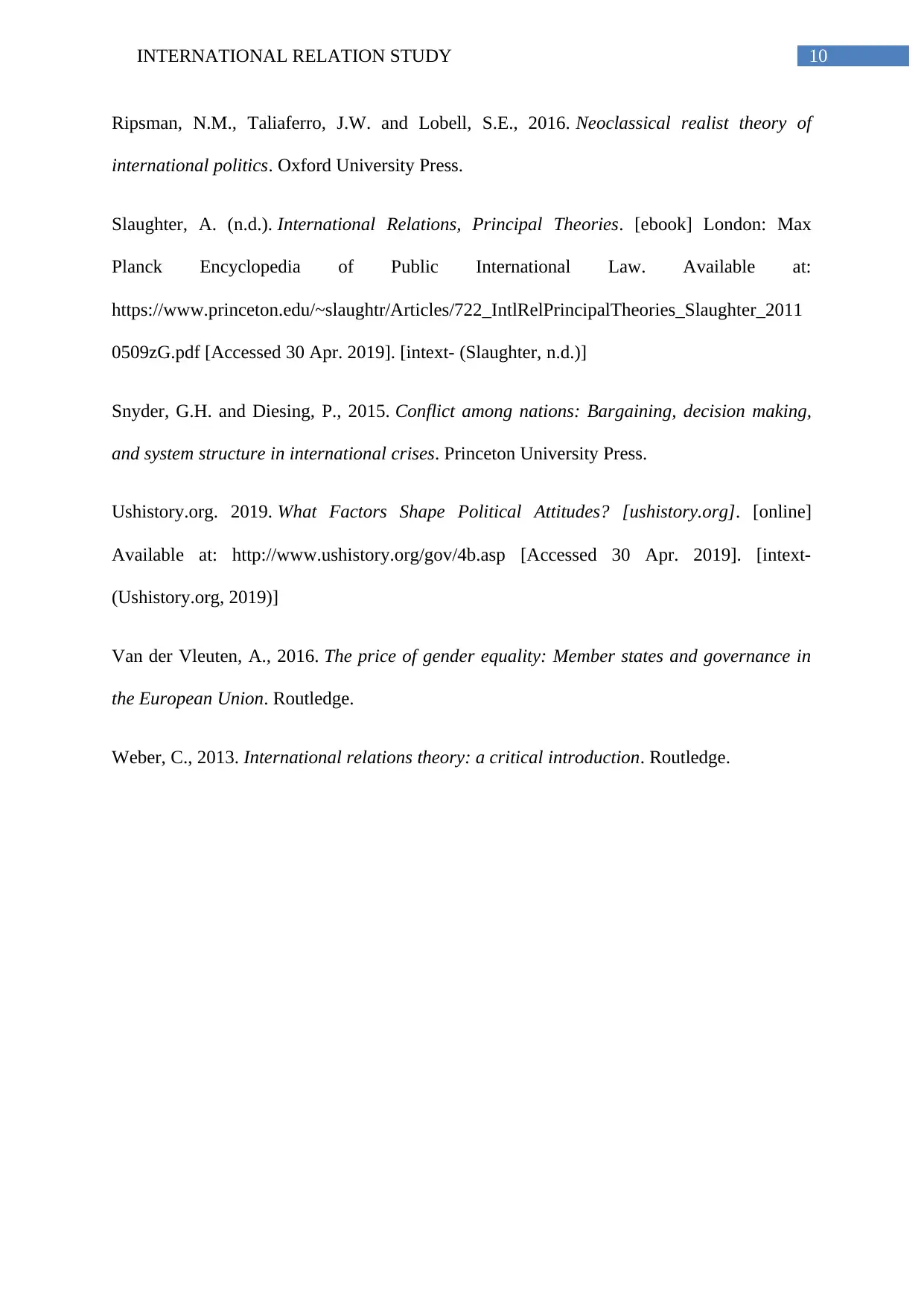
10INTERNATIONAL RELATION STUDY
Ripsman, N.M., Taliaferro, J.W. and Lobell, S.E., 2016. Neoclassical realist theory of
international politics. Oxford University Press.
Slaughter, A. (n.d.). International Relations, Principal Theories. [ebook] London: Max
Planck Encyclopedia of Public International Law. Available at:
https://www.princeton.edu/~slaughtr/Articles/722_IntlRelPrincipalTheories_Slaughter_2011
0509zG.pdf [Accessed 30 Apr. 2019]. [intext- (Slaughter, n.d.)]
Snyder, G.H. and Diesing, P., 2015. Conflict among nations: Bargaining, decision making,
and system structure in international crises. Princeton University Press.
Ushistory.org. 2019. What Factors Shape Political Attitudes? [ushistory.org]. [online]
Available at: http://www.ushistory.org/gov/4b.asp [Accessed 30 Apr. 2019]. [intext-
(Ushistory.org, 2019)]
Van der Vleuten, A., 2016. The price of gender equality: Member states and governance in
the European Union. Routledge.
Weber, C., 2013. International relations theory: a critical introduction. Routledge.
Ripsman, N.M., Taliaferro, J.W. and Lobell, S.E., 2016. Neoclassical realist theory of
international politics. Oxford University Press.
Slaughter, A. (n.d.). International Relations, Principal Theories. [ebook] London: Max
Planck Encyclopedia of Public International Law. Available at:
https://www.princeton.edu/~slaughtr/Articles/722_IntlRelPrincipalTheories_Slaughter_2011
0509zG.pdf [Accessed 30 Apr. 2019]. [intext- (Slaughter, n.d.)]
Snyder, G.H. and Diesing, P., 2015. Conflict among nations: Bargaining, decision making,
and system structure in international crises. Princeton University Press.
Ushistory.org. 2019. What Factors Shape Political Attitudes? [ushistory.org]. [online]
Available at: http://www.ushistory.org/gov/4b.asp [Accessed 30 Apr. 2019]. [intext-
(Ushistory.org, 2019)]
Van der Vleuten, A., 2016. The price of gender equality: Member states and governance in
the European Union. Routledge.
Weber, C., 2013. International relations theory: a critical introduction. Routledge.
1 out of 11
Related Documents
Your All-in-One AI-Powered Toolkit for Academic Success.
+13062052269
info@desklib.com
Available 24*7 on WhatsApp / Email
![[object Object]](/_next/static/media/star-bottom.7253800d.svg)
Unlock your academic potential
Copyright © 2020–2025 A2Z Services. All Rights Reserved. Developed and managed by ZUCOL.




